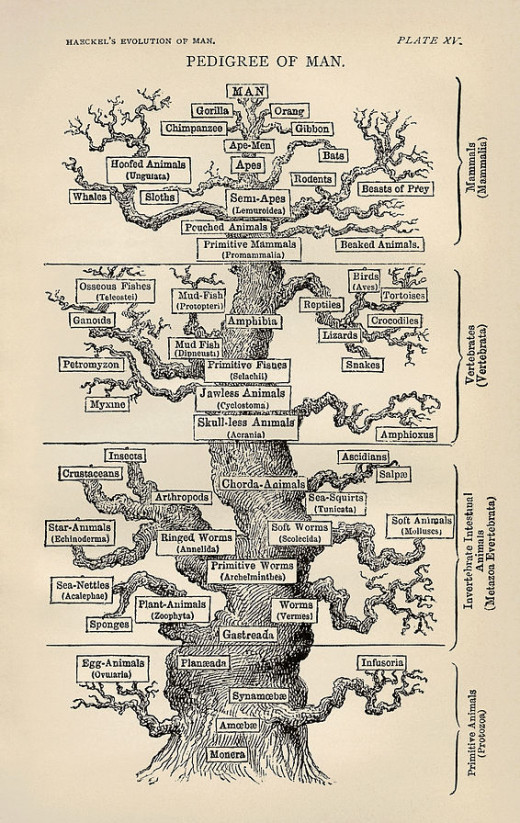Learn French with Ease: Use English to your Advantage when Learning French
French is among the most commonly studied foreign languages. For Western scholars in the arts and humanities, it is practically an academic imperative to be able to read in French and laypeople can benefit from knowledge of such an influential European language. The French speaking world has made profound contributions in the fields of literature, philosophy, art, politics, commerce, and law, to name a few. Although French does lend itself well to translation into English, direct access to the above-listed fields through knowledge of French is much more rewarding and effective. The best part of this, as I shall explain, is that French is not very difficult at all for native English speakers to learn, provided they take the right approach and have the right attitude.
Ernst Haeckel's "Tree of Life"

How Languages are Related
The reason why French is one of the easiest languages for English speakers to learn is that French and English are not only closely related, but their relationship is also very unique. The majority of languages spoken today are not isolated entities in and of themselves; they are part of a linguistic continuum, sharing varying degrees of similarity with the languages to which they are related. To further complicate the matter, similarity between two languages does not always correlate with how closely related they are. A notable exception to the linguistic continuum is Japanese, which has no living relatives.There were a variety of distinct Japanese languages, but the centralizing influence of a powerful ruling class has historically resulted in the extinction of intermediary dialects between related languages. The relationship between different languages is comparable to evolution through natural selection. When a group from one species is isolated and thrives in an environment separate from the rest of their species, natural selection gradually changes them to adapt best to the new environment whilst the rest of the species continues on a different evolutionary trajectory. Now suppose a group from the isolated subsection of the species migrates to an even more distinct environment to which natural selection shapes them to adapt. Over time, we will have three different species which are obviously related, but no longer the same. Now suppose that the first group to become isolated and changed goes extinct some time after the third group breaks off from them. Without this intermediary between the three related groups, the two most extreme ends of the related species seem less closely related. The process of evolution by natural selection is much more complex than this scenario implies, but the principle is the same. Different species arise when groups of the same species are isolated from one another and continue down separate evolutionary trajectories. The extinction of intermediary species diminishes the appearance that these species were ever related. We have the same situation with the evolution of languages. For example, if it were not for Dutch, the relationship between English and German would be much less apparent. Historically, people who spoke the same language often traveled away from one another and the lack of linguistic exchange between, say, two groups of people speaking the same Latin dialect gave rise to Spanish and Portuguese. Throughout the history of these languages, and all other languages with corresponding related languages, separation and isolation has allowed the same languages to shift into dialect forms of one anther, and eventually, into distinct languages. Take a moment to review the chart below which outlines the relationships (family tree) of the Indo-European languages, of which French and English are a part. Pay particular attention to the Italic and Germanic branches.
The Indo-European Languages

As you can see, English and French are related to one another as they both belong to the Indo-European language group. However, according to the tree, they are no more related to one another than German is to Italian, or Dutch to Spanish. The unique relationship between English and French does not stem just from their shared status as Indo-European languages, but also from the profound impact French had on the English language during the Norman Conquest.
William; Duke of Normandy

Norman Conquest of 1066
The primary reason why English shares so many similarities with French can be traced back to the Norman Conquest of 1066, when William, Duke of Normandy, defeated King Harold and assumed the English throne. Interestingly, the Normans themselves were originally Norse-speaking Scandinavians who settled in France approximately 200 years prior to the Norman Conquest and were so thoroughly assimilated by French language, culture, and society, that they were ethnically French in a few short generations. Following the Norman Conquest, French became the language of English government, law, high culture, literature, and that of the general aristocracy, whilst English remained the language of the lower class, uneducated general public (the peasantry). Over the following centuries, Norman French had become so deeply ingrained in matters of law and government, as well as literary language, that by the time Henry IV, the first Anglophone King of England since before the Norman Conquest, ascended the throne, widespread use of the English language could not function without the French vocabulary and means of expression that had become so indispensable in expressing concepts of governance and high society.
The Unique Relationship between French and English
As I have explained, English and French are both Indo-European languages. This means that they both trace their origin to an undocumented, yet theoretically plausible ancient language. As such, a native English speaker should pick up intuitively on ancient similarities between French and English, such as the way both use an "M" sound to express first person self-reflection and possession; "me" and "my" in English, and "m'/me/moi" and "mon/ma/mes" in French. This example demonstrates one of the ways in which French grammar is more complex than that of English, but also how one can use the shared origin of these two languages for one's benefit as a learner.
Not only do English and French both belong to the Indo-European language group, but as a direct result of the Norman Conquest and continued acceptance of French loan words into the English language thereafter, a large proportion of the English language is comprised of French vocabulary and even French sentence structure. Of course, there is a difference in pronunciation, but the rules of French pronunciation are much more regular than those of English. Furthermore, English before the Norman Conquest was a heavily inflected language whose nouns were declined in a manner comparable to modern Icelandic or Russian. Because of the influence of French over English following 1066, English started to become a primarily analytic language, like French, rather than inflectional.
To conclude, the English speaking student of French need only approach the language with a creative and open mind in order to benefit from the unique relationship between the two languages in order to aide his or her study.






